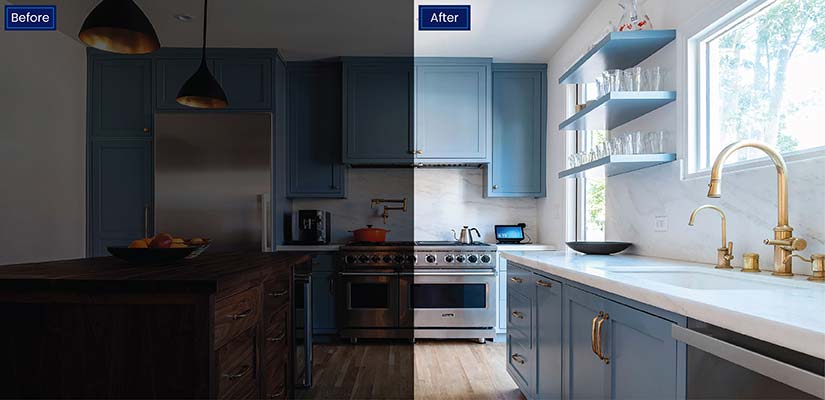- Choosing the right real estate photo editing partner impacts property engagement, sales velocity and brand credibility.
- Choose editing partners based on service offerings, consistency standards, communication and pricing that delivers good ROI.
- For long term success prioritize partners that offer customization, strong data security and adaptability to market changes and visual technology.
Table of Contents
- What is the importance of real estate photo editing
- How to identify your real estate photo editing needs
- How to choose the right real estate photo editing company
- What to consider in long-term partnerships with photo editing companies
- Future-proofing your choice of real estate photo editing service
- Conclusion
Real estate businesses often struggle to maintain consistent image quality across listings while trying to meet tight marketing deadlines. In-house photo editing becomes a resource drain, taking teams away from core activities like client relationships and property sales. This affects listing performance and brand reputation.
Working with a specialized real estate photo editing company helps turn ordinary photos into compelling visual narratives. However, this needs expertise. Professional photo editing services do this job of improving property images using advanced techniques like color correction, lighting optimization and feature enhancement while keeping them authentic and accurate.
In this article, we discuss how to choose the best real estate photo editing partner by evaluating service quality, operational fit, and long-term value. This will help you get better listing engagement and faster sales.
What is the importance of real estate photo editing

Professional real estate photo editing turns ordinary listings into marketing powerhouses that drive engagement, speed up sales and strengthen your brand.
Improving first impressions and online engagement
According to the National Association of Realtors, 87% of buyers are influenced by property photos. And the quality of these photos is influenced by professional photo editing that grabs attention in a sea of competing listings.
Properties with professionally edited photos receive more qualified inquiries and site visit requests than those with standard photography. And getting more online views means more website traffic and listing engagement.
Driving faster sales and higher property values
The direct correlation between image quality and market performance is clear from the fact that properties with professionally edited photos sell 32% faster than those with standard photography. Reduced time on the market means more commission earnings and less carrying costs for sellers, creating value throughout the transaction chain.
High-quality imagery also creates the perceived value that buyers carry into negotiations. A Redfin survey shows properties marketed with professionally enhanced images get a 47% increase in asking price per square foot.
Building a strong brand and professional credibility
Consistent high-quality visual content is a brand differentiator in a crowded real estate market. For agents and brokerages, professionally edited imagery shows attention to detail and commitment to excellence—what clients look for when choosing property representation.
For larger brokerages and teams, professional real estate photo editing ensures visual consistency across multiple listings from different agents. Consistency reinforces brand recognition and maintains quality standards regardless of individual agent photography skills, creating a cohesive brand presence that strengthens the market position.
Turn dull images into vivid property showcases.
Enhance lighting and colors for great visuals.
How to identify your real estate photo editing needs
Before choosing an editing partner, assess your unique image challenges, business goals, and operational requirements to choose the service best suited for your business needs.
What are your core image weaknesses
When partnering with a real estate photo editing company, you need to first understand your specific image challenges. Common technical weaknesses are:
- Inconsistent lighting between natural and artificial sources
- Poor composition that distorts room proportions and makes spaces look smaller
- Cluttered spaces with personal items
- Unwanted elements that draw attention away from key property features
Different types of properties have unique challenges that require different editing approaches. Luxury properties need detail without over-processing. Commercial properties require technical corrections that emphasize space and functionality.
Vacant homes need virtual staging and editing companies that provide this help buyers see potential in empty spaces. Older properties require suitable lighting and color correction for dated features.
What are your strategic business objectives
Your choice of real estate image editing services should go beyond just improving image quality. Consider the following when making your choice:
- Faster sales cycles with higher-quality images that attract more interest
- Premium listing status in competitive markets with better visual presentation
- High-volume handling for agents managing multiple concurrent listings
You need to ask yourself: Will edited images need to work across multiple platforms—from MLS listings to large-format print materials? Are you building a brand that requires consistent editing styles across all listings?
Having clear goals for your online presence and marketing campaigns will help you choose an editing partner that fits your vision and can adapt to your changing needs.
How much image volume and turnaround do you need
Realistic assessment of your image volume is key to choosing the right service. Calculate your daily or weekly photo volume to ensure capacity. Specify your desired turnaround times (12-24 hours for standard edits, expedited options for urgent listings)
Seasonal fluctuations can dramatically affect volume requirements, creating bottlenecks if editing capacity is insufficient. Make sure your chosen partner can scale services during peak periods while meeting your specific turnaround requirements.
How to choose the right real estate photo editing company

Choosing the right real estate photo editing partner requires evaluating service capabilities, quality standards, operational workflow and value proposition across multiple dimensions.
Comprehensive assessment of service offerings
Every real estate photo editing company offers basic services that should include:
- Color correction to get interior spaces accurate and consistent
- Exposure adjustment to balance bright windows with properly lit interiors
- HDR photo editing for real estate images to capture full dynamic range in tricky spaces
- Perspective correction to fix distortion from wide-angle lenses, especially indoors
- Image sharpening and noise reduction for clean results
- Proper cropping and sizing for uniform presentation
Also, look for providers that offer these advanced features to boost property presentation:
- Sky replacement to turn overcast days into blue skies
- Day-to-dusk conversion (virtual twilight) to create the “golden hour” effect
- Object and clutter removal to get rid of distractions
- Lawn and landscape enhancement to highlight seasonal properties
- Aerial and drone photo editing to show property scale and context
The most comprehensive property photo retouching services go beyond traditional enhancements to include virtual staging to turn empty spaces into furnished environments, virtual renovation to show modernized finishes, and immersive 360-degree property tours for better visualization.
Thorough quality and consistency evaluation
Evaluate company portfolios thoroughly to see beyond marketing claims by looking at multiple examples across different properties and lighting conditions. Focus on natural appearance and photographic integrity rather than over-processed results. Look for quality issues like haloing, unnatural color shifts, and distorted proportions that create jarring visuals.
Different markets and property types require different editing styles that match your brand’s visual identity. Always ask for sample edits of your own images to see if the editor can deliver your style before making big commitments so you know they can deliver consistently.
When reviewing potential editors, use this quality assessment framework to evaluate their work across critical technical areas:
| Quality assessment area | What to look for | Red flags to avoid |
|---|---|---|
| Lighting balance |
|
|
| Color accuracy |
|
|
| Technical execution |
|
|
| Virtual additions |
|
|
Make property listings pop with vibrant skies
Expert sky replacements for amazing visuals
Evaluating operational workflow and communication
Clear revision policies separate client-focused editing services from volume-based operations. Always evaluate how many revision rounds are included in standard pricing? How do you request changes? What are the typical turnaround times for revisions? Professional partners document and apply your preferences to all orders, so revisions decrease over time.
Good communication infrastructure is key to timely project management. Assess the available communication channels and response times for each. Support availability should match your operational hours especially if you upload images outside of business hours.
Also evaluate the company’s file management infrastructure – upload/download methods, organization systems and security protocols. Carefully consider file size limits, supported formats, and naming convention compatibility with your existing systems.
Analyzing pricing structures and ROI
Professional photo editing services come in different pricing models. Per-image pricing is flexible for irregular volumes but can be expensive for high volumes. Subscription packages offer lower per-image rate for monthly commitment. Volume discounts are for bigger operations, with price reductions at specific thresholds.
Beyond the direct cost, a full ROI analysis should quantify both tangible and intangible benefits. Tangible factors are reduced days-on-market and potential selling price increases. Intangible benefits are time savings, consistent quality regardless of internal resource fluctuations, and competitive differentiation through better visual presentation.
The ideal pricing structure should match your business model and volume pattern. Seasonal businesses benefit from per-image pricing despite higher unit costs, while consistent high-volume operations should use subscription or volume discount programs.
High-volume image editing for real estate catalogs

A U.S.-based real estate photography company processed over 3,000 property images daily for digital and print catalogs. They needed consistent, high-quality edits with a 12-hour turnaround to meet publishing deadlines and maintain visual standards.
HitechDigital implemented a streamlined editing workflow, applying color correction, perspective adjustments, and object removal to ensure uniformity and quality across all images within the timeframe.
The final deliverables led to:
- 3,000+ images processed daily with 12-hour turnaround
- Consistent, high-quality edits enhancing visual appeal
- Timely delivery to meet tight publishing deadlines
What to consider in long-term partnerships with photo editing companies

Beyond service claims, long-term success depends on your editing partner’s adaptability, data security and performance during trial engagements.
Flexibility and customization
Prioritize editing partners that offer customized services for different property types and marketing channels through tiered services. Ideal providers customize workflows for your business model, including property-specific shot lists and integration with existing systems for photo retouching, video editing, and floor plans.
The best partners evolve from vendors to consultants, offering strategic guidance rather than just executing tasks. Look for companies that can adapt to your changing visual preferences, market trends, and expanding property types without disrupting workflow.
This adaptability preserves relationship value while supporting brand consistency and business growth across different real estate marketing needs.
Data security and confidentiality
When you outsource real estate photo editing, thoroughly check a company’s data protection infrastructure, including transfer protocols, access restrictions, and retention policies. Reputable providers use encrypted transfers, secure storage environments, and strict internal controls to protect client assets.
Confidentiality agreements should explicitly prohibit unauthorized sharing, portfolio use without permission, and disclosure of property details – especially for pre-market or exclusive listings. Verify compliance with data protection regulations in your area (GDPR, CCPA, etc.) especially for international providers.
Editors should maintain ethical standards by confirming they properly handle sensitive information that may appear in property images and respect owner and tenant privacy through appropriate redaction procedures.
Trial services and pilot projects
Use sample editing services (1-3 images at reduced rates) to test technical capabilities and style before making a substantial commitment. For larger operations, structured pilot projects allow you to assess quality, operational compatibility, communication, and timeline reliability – all equally important to technical proficiency in determining the relationship success.
Set specific evaluation criteria beforehand, including quality benchmarks, turnaround times, and communication standards to measure against. This way, you turn subjective impressions into objective assessment and make data-driven decisions instead of relying on samples, so the partnership delivers consistent value and supports your business goals.
Future-proofing your choice of real estate photo editing service

As buyer expectations move toward more immersive experiences, editing needs to go beyond static photography. Leading companies now offer integrated services covering traditional photography, 360° panoramas, virtual tours, and video content. Advanced virtual staging has moved from simple furniture placement to sophisticated environmental design with lifestyle elements, accurate lighting, and scale relationships.
Leading real estate photo editing companies are now using AI for automated culling to find the best composition, preliminary exposure and color enhancement, and intelligent detection for sky replacement. This speeds up the basic processing and allows human editors to focus on creative decisions.
Progressive photo editing for real estate business provides the way to achieve energy efficient processing infrastructure and sustainable business practices. Responsible editing partners have clear policies on what is acceptable enhancement versus misrepresentation so clients can navigate the balance between presenting the property optimally and maintaining transaction integrity.
Conclusion
Choosing the right real estate photo editing service is a strategic business decision with long-term implications for marketing, operations, and brand. To find the best partner, you need to systematically evaluate technical capabilities, communication infrastructure, operational compatibility, and long-term innovation potential.
This multidimensional approach will help you find partners that will grow with your business, rather than just meeting your current needs.
By following the evaluation methods discussed in this article, ou can choose the right photo editing partners to enhance property presentation, optimize marketing, and drive better business results.







